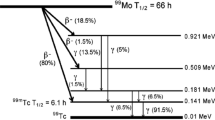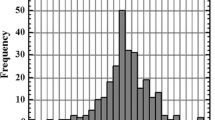Abstract
Quench effects can cause a serious reduction in counting efficiency for a given sample/cocktail mixture in liquid scintillation counting (LSC) experiments. This paper presents a simple experiment performed in order to test the influence of quenching on the LSC efficiency of 3H. The aim of this study was to investigate the behavior of several quench agents with different quench strengths (nitromethane, nitric acid, acetone, dimethyl-sulfoxide) added in different amounts to tritiated water in order to obtain standard sets for quench calibration curves. The OptiPhase HiSafe 2 and OptiPhase HiSafe 3 scintillation cocktails were used in this study in order to compare their quench resistance. Measurements were performed using a low-level LS counter (Wallac, Quantulus 1220).









Similar content being viewed by others
References
Varlam C, Ionita G, Stefanescu I, Steflea D (2001) Comparative study between external standard method and internal standard method for low-level tritium measurements. In: International Conference Nuclear Energy in Central Europe, Slovenia
Verrezen F, Loots H, Hurtgen C (2008) A performance comparison of nine selected liquid scintillation cocktails. Appl Radiat Isot 66:1038–1042
L’Annunziata MF (2012) Handbook of radioactivity analysis, 3rd edn. Academic Press, Amsterdam
Minne E, Heynen F, Hallez S (2008) Possible overestimation of the external standard quench parameter on Wallac 1220 Quantulus™ with high energetic beta-emitters. J Radioanal Nucl Chem 278(1):39–45
Wallac Quantulus 1220™ (2002) Ultra low level liquid scintillation spectrometer. Instrument Manual, Wallac, PerkinElmer, 1220-931-06
Priya S, Murali MS, Mary G, Radhakrishnan K, Gopalakrishnan RK, Goswami A (2013) Validation of chemical separation method for the determination of 63Ni using TDCR technique in steel samples of APSARA reactor. J Radioanal Nucl Chem 298:1551–1557
Wanke C, Kossert K, Nahle OJ (2012) Investigations on TDCR measurements with the HIDEX 300 SL using a free parameter model. Appl Radiat Isot 70:2176–2183
Nikolov J, Todorovic N, Jankovic M, Vostinar M, Bikit I, Veskovic M (2013) Different methods for tritium determination in surface water by LSC. Appl Radiat Isot 71:51–56
Yoon YY, Lee KY, Ko KS (2010) 14C and 3H contents in the groundwater around radioactive repository site in Korea. J Radioanal Nucl Chem 284:591–595
Jakonic I, Todorovic N, Nikolov J, Krajcar Bronic I, Tenjovic B, Veskovic M (2014) Optimization of low-level LS counter Quantulus 1220 for tritium determination in water samples. Radiat Phys Chem 98:69–76
Komosa A, Slepecka K (2010) Effect of liquid scintillating cocktail volume on 3H and 14C measurement parameters using a Quantulus spectrometer. Nukleonika 55(2):155–161
Pujol L, Sanchez-Cabeza JA (1999) Optimization of liquid scintillation counting conditions for rapid tritium determination in aqueous samples. J Radioanal Nucl Chem 242(2):391–398
Komosa A, Slepecka K (2008) Study of quenching effects for 14C and 3H measurement parameters using a Quantulus spectrometer. In: Eikenberg J, Jaggi M, Beer H, Baehrle H (eds) Advances in liquid scintillation spectrometry. Wiley, Tucson, pp 161–172
ASTM D4107-08 (2006) Standard test method for tritium in drinking water. ASTM International, West Conshohocken. doi:10.1520/D4107-08
Acknowledgments
The authors acknowledge the financial support of the Ministry of Education, Science and Technological Development of Serbia, within the project Biosensing Technologies and Global System for Continuous Research and Integrated Management No. 43002 and the Provincial Secretiariat for Science and Technological Development within the project Development and Application of Low-background Alpha, Beta Spectroscopy for the Investigation of Radionuclides in Nature.
Author information
Authors and Affiliations
Corresponding author
Rights and permissions
About this article
Cite this article
Jakonić, I., Nikolov, J., Todorović, N. et al. Study on quench effects in liquid scintillation counting during tritium measurements. J Radioanal Nucl Chem 302, 253–259 (2014). https://doi.org/10.1007/s10967-014-3191-1
Received:
Published:
Issue Date:
DOI: https://doi.org/10.1007/s10967-014-3191-1




